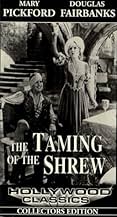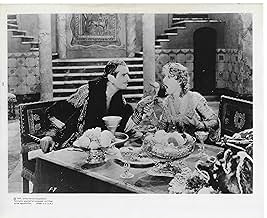In sixteenth century Padua, Hortensio loves Bianca, the youngest daughter of Baptista. But Baptista will not allow the two to get married until his eldest daughter, the extremely headstrong ... Read allIn sixteenth century Padua, Hortensio loves Bianca, the youngest daughter of Baptista. But Baptista will not allow the two to get married until his eldest daughter, the extremely headstrong Katherine, is betrothed. This task seems impossible because of Katherine's shrewish demean... Read allIn sixteenth century Padua, Hortensio loves Bianca, the youngest daughter of Baptista. But Baptista will not allow the two to get married until his eldest daughter, the extremely headstrong Katherine, is betrothed. This task seems impossible because of Katherine's shrewish demeanor. They believe their prayers have been answered with the arrival from Verona of the lust... Read all
- Director
- Writers
- Stars
- Awards
- 2 wins total
- Director
- Writers
- All cast & crew
- Production, box office & more at IMDbPro
Featured reviews
Petruchio really is quite a suitable role for Fairbanks, and his buoyant confidence works well. His portrayal seems to be pretty close to the kind of character that Shakespeare intended. The role of Katherine doesn't give Pickford a chance to use her greatest strengths. She does project good energy, and has plenty of charm when it is called for, but at times her portrayal doesn't seem to fit the original conception of the character, and the role definitely did not give Mary the chance to display her wide range of talents with more subtle material.
The story is a rather loose, jaunty adaptation of the original, and there would be little point in making detailed comparisons. As a movie, most of it works all right aside from the occasional instances of awkwardly-paced dialogue and the like that are characteristic of so many films of the early sound era. Fairbanks does help make some of these moments less noticeable with his obvious good humor. There are certainly a number of obvious ways in which it could have been better, and it's fair to point them out. Yet it still has enough of the classic story, plus enough of its own energy, to make it worth seeing as long as you know what to expect.
Variety was upbeat on "The Taming of the Shrew," commenting "While there is plenty of romance and dialog, slapstick and mud, there's no dirt, so that part of Pickford's career remains as clean as ever. Splendid settings in the Fairbanks massive production manner." Modern assessments of the film are less than praiseworthy, especially knowing in hindsight that both careers took a deep dive after the "Shrew." Says Leonard Maltin, the movie "was defeated by its lack of pacing and downright embarrassing performances, though it's undeniably fascinating to see Doug and Mary together in their only co-starring appearance." Years later, Pickford said it was her worst performance of her life. She did admit, however, that Fairbanks excelled as his portrayal of Petruchio.
"The Taming of the Shrew" was the first Shakespearian play brought to the screen as a talkie. The feature film was based more on the Richard Garrick's version of the farce, his 'Katherine and Petruchio.' The 1929 film incorporates about 20 percent of Shakespeare's written dialogue, and the movie's English, still Elizabethan, is updated somewhat to make it more understandable for the modern audiences.
Today's viewers to "The Taming of the Shrew" will take notice that Fairbanks' harsh treatment of Katherine is so over-the-top many felt back then the actor was taking out all his frustrations of the couple's personal relationship out on her. And Pickford's punchy attitude was equally demonstrative by her excessive yelling and physicality towards him, portions that were not written in the script. Pickford claims all the fault laid at the director, Sam Taylor's feet, a surprising allegation since both he and the actress got along swimmingly during their last collaboration, 1927's "My Best Girl."
As one reviewer noted, "The acting that had made Pickford and Fairbanks the 'King and Queen of Hollywood' rendered their performing style obsolete overnight. It's important to remember, of course, that the change brought about by sound had absolutely nothing to do with their deficiencies as performers, but only emphasizes the differences between silent and sound film. Watching a film like 'The Taming of the Shrew,' and comparing it to what they were both doing just months earlier, makes a strong case that the silent and sound film are really two entirely different things."
The big problem is that Pickford is so small; when I got my first look at her, she looked like a little girl playing at fancy dress. Taylor stages things so she is equal in height or taller than Fairbanks when they are side by side, but when standing apart she is obviously much shorter. Maybe a match in bad manners, but she is obviously not his physical equal. For example, she is blown about by a high wind in one scene, while Fairbanks is unaffected.
Fairbanks as Petruchio is actually playing one of his swashbucklers, and Pickford as Kate is one of her many spunky waif characters. She does not inspire fear, just a "isn't that precious!" reaction given her size. Notice that when Pickford is supposedly beating up servants and smashing furniture, she does so out of view of the camera, because someone her size would not be capable of doing all of that damage.
The odd thing is that the film looks like great care went into the art direction and photography, and the supporting players are pretty good. Neither Fairbanks nor Pickford have that stiff early talkie way about them, but they are given to wild gestures as though they are still in a silent film. So it is the little things that are done well and with care, while it is the big things that sink the film. I'd give it 5/10 with four of those five going to the physical production design.
Did you know
- TriviaIn her later years, Mary Pickford stated that working on the film was the worst experience of her life, although she also acknowledged that Douglas Fairbanks's performance was one of his best.
- Alternate versionsAfter many years out of circulation, the film was re-released in 1966 in a new cut supervised by Mary Pickford herself. New sound effects were added throughout, much of the voice dubbing was enhanced with newly available technology, and seven minutes were cut from the initial print. This re-released version is the only version now available on DVD or VHS.
- ConnectionsFeatured in Mary Pickford: A Life on Film (1997)
Details
- Release date
- Country of origin
- Language
- Also known as
- The Taming of the Shrew
- Filming locations
- Production companies
- See more company credits at IMDbPro
Box office
- Budget
- $504,000 (estimated)
- Runtime1 hour 3 minutes
- Color
Contribute to this page






























